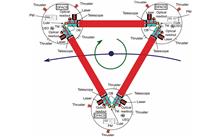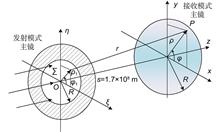
This paper focuses on the ultra-low thermal deformation requirements of the main support structure of the gravitational wave detection telescope. It proposes a method to reduce the thermal deformation of the truss support structure by designing CFRP (carbon fiber reinforced polymer) layers to modify the material's thermal expansion coefficient. Additionally, to meet the alignment performance requirements of the telescope, a segmented design scheme for the structure is presented. The paper begins by analyzing the advantages of CFRP, existing methods of thermal dissipation, and the research progress both domestically and internationally. It determines the three-segment telescope design using CFRP as the support material and establishes design criteria. Next, mathematical models for "material-thermal deformation" and "truss structure-thermal deformation" are developed. Optimization is conducted for material layering and structural design, resulting in an optimized solution. Furthermore, CFRP materials are applied to the support structure, and a segmented main support structure design scheme is proposed to reduce the difficulty of structural processing and alignment. The overall structure is analyzed. The analysis results demonstrate that, in terms of mechanical performance, the overall structure's natural frequency and maximum gravity-unloading deformation meet the requirements of the main support structure. In terms of thermal deformation, the optimized design based on CFRP layering exhibits a thermal deformation that is 27.15% of the conventional layering scheme, 6.42% of the Invar material support rod scheme, 11.50% of the SiC support rod scheme, and 3.21% of the titanium alloy support rod scheme. This indicates that the optimized design can significantly reduce the structural thermal deformation.
Gravitational wave detection imposes high stability requirements on telescopes in space. To achieve independent measurement and calibration of the optical path stability accuracy of the telescope, the research was conducted on corresponding measurement methods. Based on the principle of heterodyne interferometric measurement, a high common-mode suppression interferometric measurement scheme was designed, and an optical path noise theoretical model was established. According to the requirement of 1 pm/Hz1/2@1 mHz for optical path stability indicators, the optical path noise level of the measurement system components was allocated. To verify the feasibility of the scheme and the accuracy of the noise theoretical model, an interferometric measurement system was constructed at the front end of the telescope. According to the relevant parameters of the experimental instruments and optical components, the theoretical evaluation of the system's optical path noise level was 7.319 nm/Hz1/2@10 mHz. The experimental measurement result of 3 nm/Hz1/2@10 mHz was consistent with the theoretical evaluation, indicating that the interferometric path has good noise common-mode suppression characteristics, and verifying the accuracy of the noise theoretical model. When the testing environment and instrument accuracy meet the requirements for optical path noise allocation, this measurement scheme is expected to achieve the measurement of the optical path stability of gravitational wave telescope.
In the space gravitational wave detection system, the accuracy of the complex amplitude field distribution simulation at the telescope exit pupil closely affects the accuracy of the interferometric measurement and impacts the effectiveness of TTL noise control analysis. Therefore, it is necessary to carry out the high-precision diffraction calculation for the field propagation. This paper demonstrates the necessity of the vectorial ray-based diffraction integral algorithm for simulation and illustrates the algorithm flow combining the telescope model. A computational model was established based on the algorithm. The telescope system parameters were substituted to verify the wavefront calculation accuracy, and the vectorial field simulation results were presented. Based on the system model, the effects of the input Gaussian field parameters and the complex refractive index on the output vectorial optical field characteristics are simulated.
The telescopes for space-based gravitational wave detection are used to transmit the laser beam between spacecraft to support the precise interference measurement system. Therefore, the optical path stability of the telescope has become a crucial technical parameter. In this system, pupil aberrations provide deeper insights compared to traditional image plane aberrations in understanding optical path stability requirements, evaluating telescope imaging quality, and suppressing tilt-to-length coupling noise. Based on the theory of traditional imaging aberration and pupil aberration theory, the initial structure of the telescope is established, and the automatic correction of pupil aberration and image plane aberration is achieved through macro programming in the commercial optical software Zemax, thus achieving the design of a high-performance spaceborne telescope. Simulation results demonstrate that the design can meets the requirements of the TianQin mission.
Accurate measurement and control of wavefront aberrations in space-based telescopes are key to achieving efficient space gravitational wave detection. This paper presents a method for measuring wavefront aberrations of space-based telescopes based on the Shack-Hartmann wavefront sensor. This method employs a cross-correlation algorithm in the frequency domain after frequency domain threshold denoising. The measurement accuracy of the algorithm is verified using a Shack-Hartmann wavefront sensor with 20×16 sub-apertures, microlens dimensions of 0.279 mm×0.279 mm, and a focal length of 34 mm. Point source images with known defocus RMS values (0, 0.22, 0.44, and 0.66 nm) are generated, producing point source images with displacements. After wavefront reconstruction using the modal method, the RMS values of the reconstructed and residual wavefronts are calculated, comparing the measurement accuracy of the cross-correlation algorithm in the frequency domain with the traditional centroid algorithm. The results show that as the actual defocus value increases, the measurement error of the centroid algorithm presents an upward trend, respectively at 0.0966 nm, 0.1378 nm, 0.1284 nm, and 0.1463 nm. The cross-correlation algorithm in the frequency domain can increase the measurement accuracy by 13%, 7%, 18%, and 14% respectively, providing an important reference for the high-precision testing of wavefront aberrations of space gravitational wave space-based telescopes on the ground.
The optical telescopes for space-based gravitational wave missions play an important role in the measurement, which both expand the beam going to the far spacecraft and efficiently collect the beam sent from the far spacecraft. The telescope, as part of the interferometric path, directly affects the measurement noise. Compared with the imaging system, the telescope for space gravitational wave observatory not only has high requirements on wavefront quality, but also has extremely high requirements on stray light performance and optical path stability, and the latter two are more challenging. The research progress of the telescope's optical system, optical-mechanical structure, space environment and thermal design, stray light simulation and suppression, and stability measurement is reviewed, which can provide a reference for the development of space gravitational telescope in our country.
In gravitational-wave detection systems, the surface scattering properties of ultra-smooth optical components play a crucial role in achieving high-precision gravitational-wave measurements. To analyze and predict the surface scattering properties of ultra-smooth optical components accurately and rapidly, a non-paraxial scalar scattering model, the Generalized Beckmann-Kirchhoff (GBK) model, was built up. On this basis, the influences of both the incident angle and the scattering azimuth angle on the angular resolved scattering distributions of both P-polarized and S-polarized incident light were investigated. Under different statistical distribution characteristics of optical surfaces, the effects of incident angle, azimuth angle, autocorrelation length, slope, cut-off frequency, and surface roughness on the scattering angle resolution distribution were analyzed. The research results can provide useful references for the manufacturing of ultra-smooth optical components and the generation and mitigation of stray light in gravitational-wave detection systems.
The point ahead angle mechanism (PAAM) is a key component of the space gravitational wave detection telescope. It can control the displacement of the telescope precisely by inputting voltage or charge to the piezoelectric actuator. Therefore, the displacement response of the piezoelectric ceramic actuator directly affects the pointing control performance of the PAAM. In this paper, the equivalent capacitance calculation method is proposed to quantitatively analyze the displacement response characteristics of piezoelectric actuators driven by charge, and the accuracy and feasibility of the calculation method are verified by numerical simulation and experimental verification. The results show that when a charge amplifier controlled by 5 V, 0.05 Hz~5 Hz sine wave signal is used to drive a certain type of piezoelectric actuator, the maximum deviation of displacement response between the analysis results and the experimental results is within 1.35%, which provides a possible analysis method and realization way for the high-precision pointing control of the PAAM of the space gravitational wave detection telescope.














